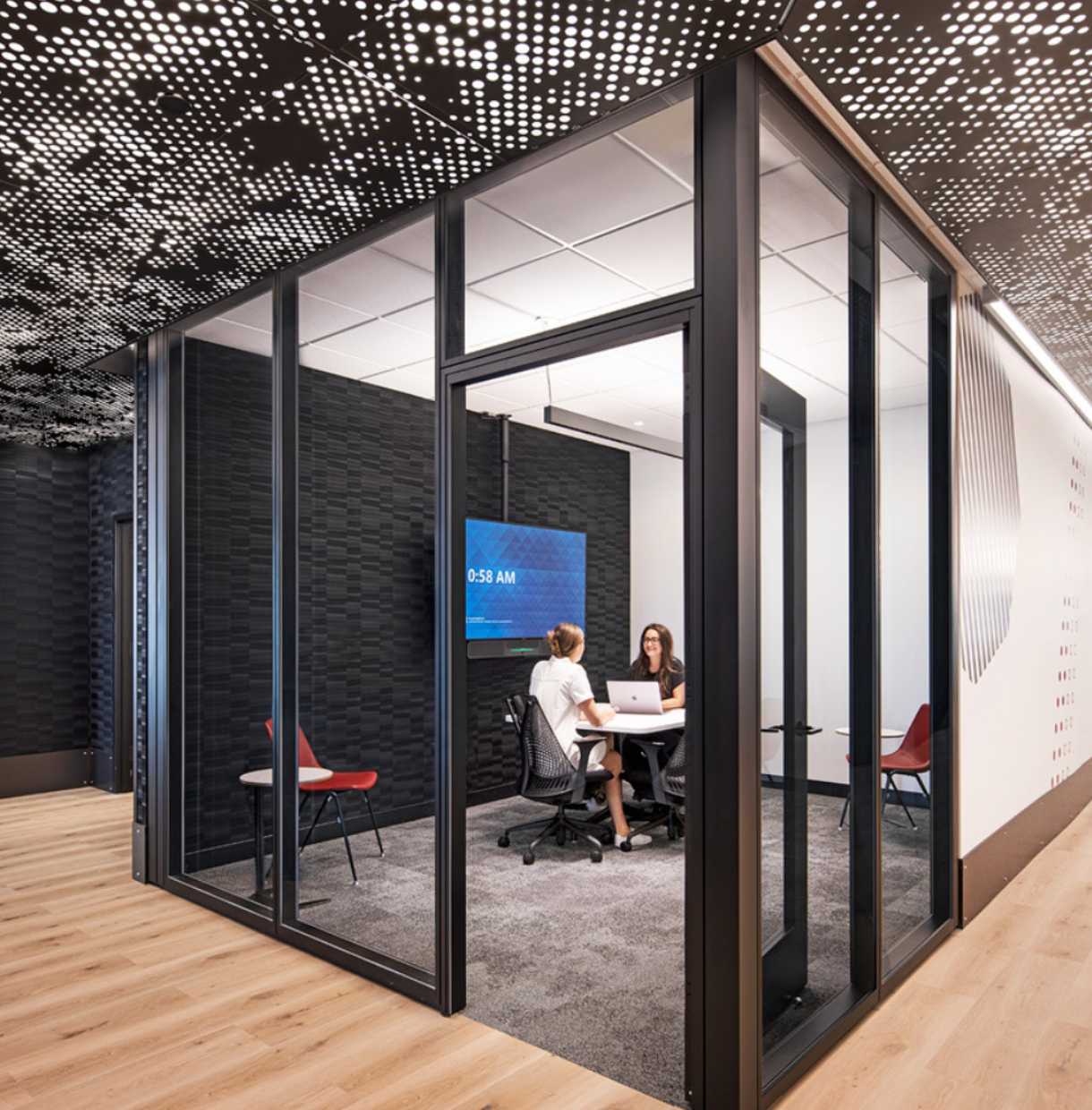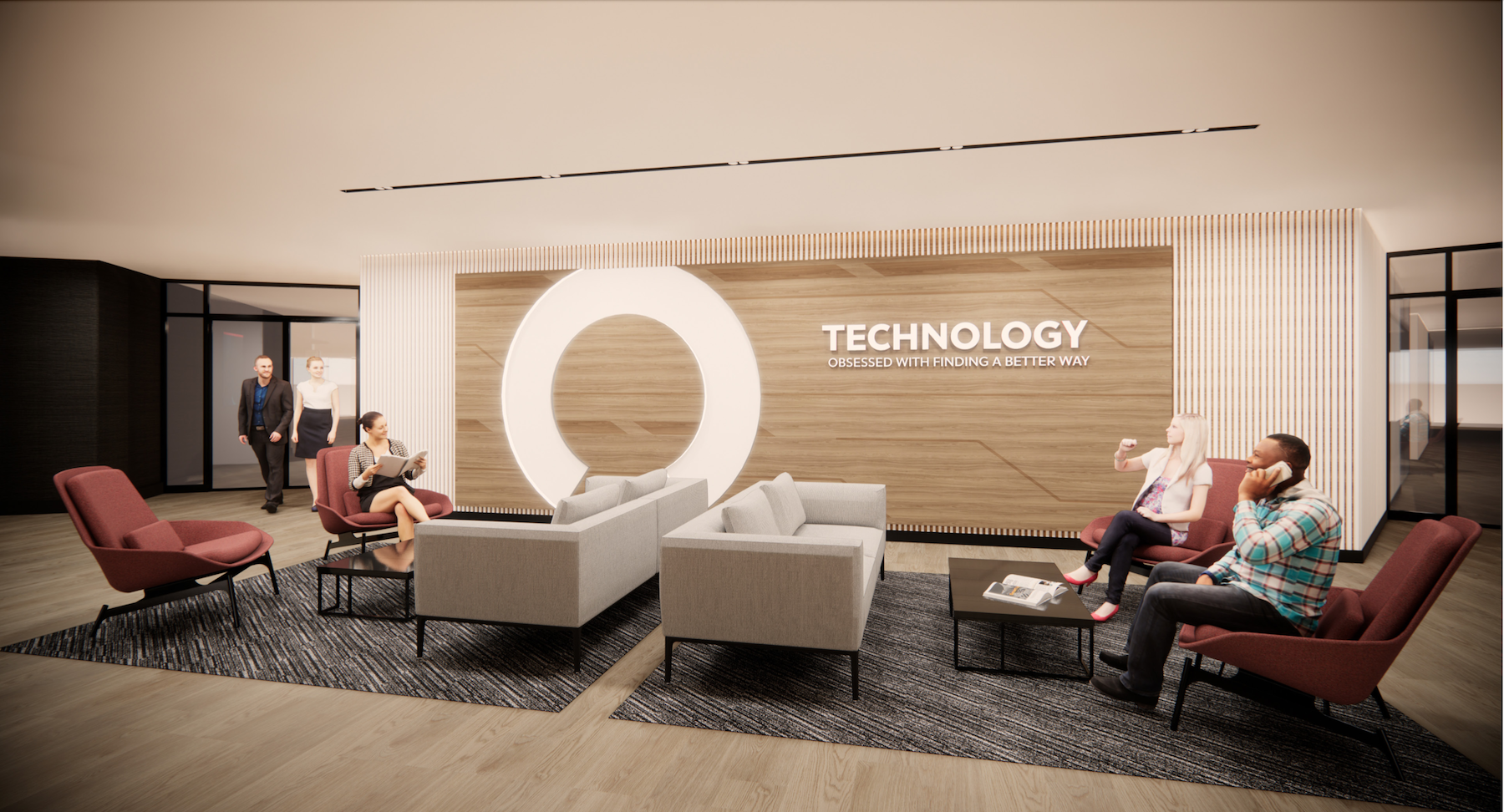The Rock Family of Companies, which includes Rocket Mortgage and Quicken Loans, is one of Detroit’s largest employers, with 17,000 workers. Over the past several months, many of those employees have been returning to their offices, more than 1 million sf of which in several buildings were renovated in 2020, while those spaces were closed because of the coronavirus pandemic.
Pophouse—a nine-year-old interior design studio owned by Jennifer Gilbert,, the wife of Dan Gilbert, Rock’s chairman and majority owner—came up with the design concept for this renovation project through a pilot program at Rocket Mortgage Technology’s four-story 288,000-sf headquarters in the One Campus Martius Building that, initially, involved around 40 employees for several months in 2019, and then was refined to the point where it could be rolled out for 2,000 workers.
“The goal was to offer a destination and collaborative space for innovation,” says Mike Malloy, Chief Amazement Officer for Rock Central, a professional services firm that’s part of Rocket Companies. Jennifer Janus, Pophouse’s President, says her firm’s mission on this project was to create a positive impact on employees and visitors by using data and metrics to inform its design.
Five parameters defined the pilot’s design:
•Culture + Community, where branded moments demonstrate organizational identity;
•Team + Wellness, where workers are exposed to the outdoors and natural light;
•Collaboration that allows team members to work together within new orientations;
•Tech Integration that reduces extraneous equipment and facilitates team meetings wherever employees are working;
•Flexible Amenity Settings, where private offices are designed with small or larger gathering tables, where team ownership of spaces allows each group to manage its physical assets, and where communal amenities, like kitchens and conference rooms, support all individuals on that floor.
OFFICES WERE BEING USED SPARSELY

A survey of employees for the pilot found that 90 percent would use a quiet place at work if it were made available, and that 80 percent wanted more conference rooms. More significant were the findings that 36 percent of room needs per hour were for two-person meetings, and that on an average day 30 percent of the office’s tech team does not come into the building, and that even at its highest level, 20 percent aren’t in the office on a given day.
Pophouse, working with the GC Braun Construction Group and the architect Rossetti, tested all kinds of things: smaller desk surfaces, collaborative zones and software, training areas, additional monitors for teams to use, desk utilization, and digital behaviors.

It found that workers could acclimate themselves to a smaller, five-ft desk surface; that they preferred high-top tables to casual seating in collaborative areas; that non-bookable team spaces were “highly valued” and led to different employee behaviors and team rituals; that flexible conditions resonated positively; that new technology should be deployed and tested thoroughly; and that finding solutions that permit onsite and remote work transparently was imperative.
The test space contained new types of work settings for the team to leverage. These included one-on-one spaces, smaller collaborative spaces with soft seating, quiet areas, so-called “touchdown” spaces for spontaneous and quick interaction, and enhanced tech to improve the remote working experience.
Pophouse’s “neighborhood” concept included determining a kit of parts creating a “home base” for team members, which would allow an “ecosystem” of work settings for individuals to choose from. The concept reduced the quantity of workstations but increased the number of overall seats per floor.
OFFICE-TO-RESIDENTIAL COULD BE NEXT OPPORTUNITY

The firm’s pilot design—which assumes a hybrid work model—revolves around these principles: culture is key, variety over repetition, full sensory performance that reduces distractions, a spectrum of shared and individual spaces, a “playground of perspective” where teams share a “home,” the smart home that functions seamlessly with the office space, a clutter-free workspace, authenticity, and “driven simplicity.”
As the design was applied to offices in other Rock-owned buildings, Pophouse worked with building teams that included the AE firm NORR and Whiting-Turner Construction.
Pophouse, with 30 employees, over the years has completed several thousand large and small projects for Gilbert’s businesses in Detroit, Cleveland, and Miami. But Pophouse still gets 40 percent of its work from other clients. Janus foresees opportunities doing more work in states like California and Florida that would include converting vacated office spaces to residential. Malloy notes that his company is “intrigued” by a pending bill in Washington D.C. that would provide funding for such conversions.
Related Stories
| Apr 18, 2014
First international buildings among 700-plus certified by BOMA 360 Performance Program
In the first quarter of 2014, the Building Owners and Managers Association (BOMA) International certified 66 properties in the BOMA 360 Performance Program for commercial real estate markets across the U.S and, for the first time, abroad.
| Apr 16, 2014
Upgrading windows: repair, refurbish, or retrofit [AIA course]
Building Teams must focus on a number of key decisions in order to arrive at the optimal solution: repair the windows in place, remove and refurbish them, or opt for full replacement.
| Apr 15, 2014
12 award-winning structural steel buildings
Zaha Hadid's Broad Art Museum and One World Trade Center are among the projects honored by the American Institute of Steel Construction for excellence in structural steel design.
| Apr 15, 2014
Chipperfield's sparkling brass-clad scheme selected to be new home of Nobel Prize
The distinctive building, with its shimmering vertical brass elements and glass façade design, beat out two other finalists in the Nobel Center architectural competition.
| Apr 11, 2014
ULI report documents business case for building healthy projects
Sustainable and wellness-related design strategies embody a strong return on investment, according to a report by the Urban Land Institute.
| Apr 11, 2014
First look: KPF's designs for DreamWorks in the massive Shanghai DreamCenter
Two blocks of offices will be centerpiece of new cultural and lifestyle district in the West Bund Media Port.
| Apr 9, 2014
Steel decks: 11 tips for their proper use | BD+C
Building Teams have been using steel decks with proven success for 75 years. Building Design+Construction consulted with technical experts from the Steel Deck Institute and the deck manufacturing industry for their advice on how best to use steel decking.
| Apr 2, 2014
8 tips for avoiding thermal bridges in window applications
Aligning thermal breaks and applying air barriers are among the top design and installation tricks recommended by building enclosure experts.
| Mar 31, 2014
Removable flood prevention system installed in one of New York City's largest office buildings
EKO Flood Protection created a flood prevention solution for one of New York City's largest office buildings, 55 Water Street, that can be put up in 8 hours by a crew of 30 people.
| Mar 26, 2014
Callison launches sustainable design tool with 84 proven strategies
Hybrid ventilation, nighttime cooling, and fuel cell technology are among the dozens of sustainable design techniques profiled by Callison on its new website, Matrix.Callison.com.

















